Amplifier power supplies
Over-rating is the best way to avoid breakdowns caused by under-rating. Performance will improve and components exposed to proportionately less stress will invariably last longer, especially at elevated temperatures. Free airflow around components helps to alleviate this problem.
Manufacturers can test new designs on laboratory stabilised power supplies, often with the PCB and heat-sink operating in free air. It can be the case that the amplifier specifications quoted are those derived from use on such supplies and not those as supplied to the customer. For example, some authorities deem an adequate supply, using passive components, will comprise 1 Farad of smoothing per supply rail. No commercial design yet seen has ever matched this value.
Most power supplies are built into the same case as a power amplifier, although it is feasible to separate them. This approach may appeal to some but will invariably introduce the possibility of failure of the connecting medium and the risk of radio frequency breakthrough. It is considered best to consider power supplies and stages as a single unit, even integrating both.
Although light, high-efficiency switched mode power supplies had appeared occasionally in commercial designs (Sony, JBL and others), these, so far, have not proved popular with 'linear' designs, failures being more common than expected. Other negative factors included cost, complexity and spurious signal radiation. Proliferation of class D designs will alter this. Complete amplifier modules, with on-board mains supplies that can supply other modules, can be found at ICEpower, for example.
The usual arrangement for a commercial stereo amplifier will be a close approximation to that shown below.
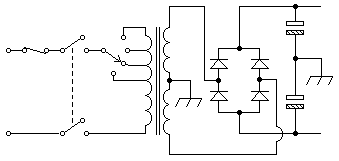
The live feed will have a fuse fitted, a double-pole switch will give air-gap isolation, a mains transformer (multi-tapped for different markets) will feed a bridge rectifier (a symmetrical rectifier arrangement will produce less transformer noise - B/H characteristics) and smoothing capacitors before the supply reaches the amplifiers, regulators, etc. Output is 140% of transformer secondary output voltage and 60% of the current.
A more considerate manufacturer might use this arrangement.
Separate supplies to both amplifiers are held to reduce crosstalk and intermodulation although this principle is often ignored in class H designs where two or more PAs may share the same supplies. A single transformer will provide better regulation and a saving on cost than separate ones. Additional smoothing in close proximity to each output device will help overcome wiring deficiencies. Sophisticated designs will feed control and protection circuitry from a separate transformer winding to reduce operating noise. At the same time, a soft-start circuit might be included to reduce the stresses of switch-on in-rush currents, a personally-held primary cause of component failure.
A large value of capacitance is considered necessary in the smoother array to avoid modulation signals on the supply lines when the demand is high, especially at low output frequencies, the charge frequency being that of the mains is not sufficiently fast to charge the array. The noise then introduced can mask small amplitude signals resulting in a loss of definition and clarity. This can be particularly true of class A designs where a constant heavy current demand is already extant and, in the past, has been overcome with regulators or even large batteries. Obviously with these means the efficiency and/or bulk of the resulting completed unit become lesser design considerations.
An attempt to reduce the bulk of the conventional power supply was made with Bob Carver's 1980 M-400 Magnetic Field Amplifier, where the (switched) transformer windings were arranged to form a saturable coil known as a 'magnetic field core' (MFC). This inductor was used to store energy for very short periods, thereby fulfilling the roles of the reservoir capacitors (now much smaller). The operation of four protection circuits was summed turning the primary's triac on and off, both amplifiers being wired anti-phase to each other. Offering nearly 300W per channel from a 7" (approx) cube, high frequency distortion was not the best and concerns were raised by the box's tendency to groan, squeak and buzz. With a 15A mains fuse currents drawn could be very high, but being out-of-phase with the voltage overall power consumption was low.
Employ star or spider earthing (bringing all earths to a single point) throughout to prevent circulating currents.
Component considerations
Anything directly connected to the mains is potentially lethal and must be considered so. Handling of live components is not an option and care to insulate exposed connections within the case must be made. At all times, before attaching instruments and handling components, first switch off the unit and discharge the electrolytics in the supply via a 15R, 5W resistor. Take care to discharge across the capacitor's terminals, and not to chassis.
All tools should be insulated and care taken when moving tools around inside an amplifier; the metal shaft say of a screw-driver falling on a live supply and power stage can result in much consternation and expense, and in a very short space of time. One chap, who did this after nonchalantly waving a screwdriver over a brand new unit, opened out of curiosity, was upset to find that human-induced faults are generally far more complex and costly than 'natural' ones.
A residual current circuit breaker (RCCB) should be somewhere in the mains feed to a system, especially when envisaging stage use. In complex systems these can be used to isolate and pinpoint trouble without (badly) affecting the rest of the system while in use. This is particularly true if a lighting rig, which should have it's own current cut-out, is run off the same supply.
When fault-finding or installing systems run on lower voltages, eg; automotive, marine, class D, etc, the use of a suitable bulb as a dummy load, whether in series with a suspect amplifier or speaker, can be of considerable assistance. As the load is driven harder, the bulb's filament's impedance rises, then limiting the current through the load.
Varistors (transient voltage suppressors)
Experience gave the best placement for these in the mains supply before the amplifier, say, in a mains connector strip or multi-way socket. Protection can then be given to an entire system, although a lightning strike may prove non-survivable. Fit fuses in both lines supplying the system then, after these, use three varistors tying (UK) L to N, L to E and N to E before the mains out. Choose as large a type that fits comfortably (or make up a separate insulated box) and fit a high-voltage capacitor or snubber network as well (L to N). 'Barrier' protection in the form of, say, 275V types preceding 250V types can be employed.
Dual bidirectional thyristor overvoltage protectors like the Bourns TISP3600F3, or Littelfuse SIDACtor devices, can provide transient protection to signal and telecoms lines and so protect their insulation. Gas-filled spark gaps should be replaced after only one 'flash-over'.
Never bend a wire or cable through a radius less than it's overall diameter. Many otherwise sound designs using excellent components are marred by tight wiring bends that can crush and damage the cores, creating potential problems at a later date and degrading HF performance. This is particularly so with screened cables whose bend radius should exceed the manufacturer's recommended minimum.
Similarly, never bundle or place signal and power cables together. Although some are convinced that this gives a neat and/or tidy finish, the result can, in fact, be detrimental to performance negating the care and consideration taken elsewhere.
Some constructors will build quite complex and extensive looms interconnecting individual PCBs which not only introduce noise but also introduce potential failure points in the form of connectors, etc. Ideally, the time and energy spent on a wiring loom can instead be more usefully used on a common PCB layout serving the entire unit which will give far better performance and reliability.
Never uprate a manufacturer's fuse rating, it is there for a very good reason and only consequent damage, usually of the expensive smoking kind, is likely to result.
Anti-surge, or time-lag, types should be used for the mains feed. A number of manufacturers fit a fuse to each of a multi-tapped transformer's 110V windings. Sand-filled and ceramic types are available for high-current situations and are prefered, given the propensity of glass to shatter or crack. Individual amplifier protection can be provided by fuses fitted after the smoothers. These, if fitted, should be fast types and rated for the load bearing in mind that a speaker's physical limitation may precede it's electrical power handling limits by a fair margin.
Fuses are usually rated at 125% of the normal load to prevent premature blowing. Bear in mind that to blow quickly a fuse must be presented with an overload of some 200%. A lower overload, say of 35% or 4A through a 3A fuse, may take an hour for the fuse to blow.
Over-rate handling current by at least a factor of two, given the surge most switches face on power up (the heat generated across the tarnished contacts of the mains switch on one volume control caused it to incinerate quite spectacularly). Apply same criteria to filters. High-voltage ceramic capacitors or snubber networks across the mains switch contacts will tend to increase life by reducing arcing.
At low voltages - 24V or below - current switching ratings can usually be increased without serious reduction of working life. Loads, other than of a purely resistive nature, invariably require derating if working life and, in some cases, safe working are to be maintained. An inductive load like a transformer may cause high voltage and current surges as the magnetic flux collapses. Such voltage surges may cause flash-over, damaging insulation.
A capacitive load generates heavy initial charging current. A similar effect occurs with filament lamps due to the cold resistance being very low - a factor which is frequently overlooked. Such current surges increase contact wear.
With complex load impedances the position becomes more complicated. In all these cases experiment under actual operating conditions is the best way to determine the measure of derating necessary. For inductive loads, derating to 20-25% is suggested as a starting point.
An AC arc tends to extinguish itself as the EMF falls to zero each half cycle. A DC arc tends to maintain itself until contact separation becomes too great in relation to the EMF. For this reason, current/power switching ratings are generally lower on DC than on AC with slow-action switches.
Switch life is normally based on 10,000 operations minimum at full ratings for a purely resistive (non-reactive) load. This covers both electrical and mechanical wear. However, the mechanical life of a relay may exceed it's electrical life by a factor of 100.
Arcing can be considerably reduced and contact life extended if capacitors or snubber networks are wired across switch contacts. In commercial units 10nF, 1kV ceramics are usually seen but integrated snubber networks will include a resistor (~120R) in series to limit current.
Wideband noise bursts associated with arcing can be carried by radiation or the building's wiring. Filters will considerably reduce noise from central heating, motors, welding kits, flourescent lighting, etc, especially when efficient wide-bandwidth mains transformers are used. Even the 'highest of hi-fi' designs can be devoid of this consideration, purely on commercial grounds, and suffer as a consequence. For example, a high-power amp left silent but switched on can destroy speakers when the central heating comes on. Units with integrated mains switches, fuse holders and sockets can be obtained, reducing construction and applying filtering at the point of entry.
Transformers can be a major influence on maximum output power and distortion, for example, in a small, well-known design the transformer showed a regulation of about 3Vrms between no load and a continuous sine output of 20W into 8 ohms. DC rail variations were as follows; quiescent = ±32V, 20W sine into 8ohms (one channel) = ±23V (71%) and driving both channels at 16W sine into 8ohms = ±17V (53%).
A number of types exist, some designers prefering C-cores, most however are either E-I or toroidal types. Compared to a conventional E-I laminated transformer, an equivalent toroidal type is in most cases 50% to 33% of the weight and size, with losses of only 10%. Stray magnetic fields are also considerably reduced, as is audible noise by the very tight 'laminations' which are then completely enclosed by the windings, effectively reducing magnetostriction. The absence of an air gap typically provides an 8:1 reduction of induced noise. Alternatively, some types may use a lower flux density. A continuously wound core has no air gap resulting in a stacking factor of 95% of it's theoretical weight. High electrical efficiencies result when the magnetic flux is in the same direction as the grain oriented silicon steel core.
Half wave rectification circuits should be avoided because they cause the hysteresis loop to become assymetrical about the B/H axis. When this happens the core becomes polarised and saturates in one direction causing increased iron losses and mechanical noise. The use of balanced bridge rectifiers overcomes this problem.
The major disadvantage inherent in toroidal types is their wideband characteristic allowing them to pass more mains-borne noise to the supply, this being due to the capacitive coupling between the primary and secondary. For this reason screened types should be used and these can be of copper tape with 10% overlap, or 33% with a final ICM overlap. With E-I types using a split bobbin, capacitive coupling between the windings is minimised, a copper strapping reducing radiated hum. Occasionally an extra winding is wired to a large capacitor (sometimes as large as the transformer) to form a magnetic choke. In either case, attention paid to mains filtering is recommended since, in true hi-fi, a power supply must be silent.
To deliver 100W into the commonest loads an amplifier must provide outputs as follows, per speaker load;
An upper figure will usually be given with only one channel driven. Two separate amplifiers of the same specified output can sound very different if one's supply is under-rated, clipping occuring sooner, thus making the amplifer with the better supply sound 'cleaner'. A number of user/owners have made unsolicited reports of improvement in sound quality when a burnt out transformer is replaced with a larger one. To be sure, add the total amplifier current consumption, including power stage losses (ie; for class AB double the design output), and select the next size up. This is a good time to consider output device heat-sinking requirements and arrangements; assuming an amplifier efficiency of 60% (class AB or B). A rough rule of thumb gives 2.5°C/W for a 100VA transformer, 5 for 50VA and 1.2 for a 200VA.
Personal preference has always erred to overating an output stage's safe operating voltage. For example, if a design can run at ±55V, no significant subjective difference will normally be noticed if the supply is run at ±40V, the mechanical handling capacity of the load usually imposing limitations long before the rated electrical handling is exceeded. Notwithstanding the reasonable desire for 'reserve power', it can often be the case that no real benefit may accrue by trying to stretch a design to potentially deliver 150W, which will probably be never used, when a comfortable 75-100W maximum, or less, is all that will be likely to be required. If a conflict arises between marginal voltage and VA ratings in a given type, opt for a lower output voltage. A mains transformer of the same rating, but lower output voltage, will provide better regulation and will also reduce the stress on the output stage increasing safe power handling capability and, thus, longevity.
Designs with larger transformers may require soft-start circuits to prevent the mains fuse blowing on switch on, especially with toroidal types which use less copper wire (reducing winding impedance) and a high-grade core material. With no magnetic field established and discharged smoothers the fuse often sees a near short-circuit when an amp is turned on, and does it's job. For this reason a toroidal type's mains fuse will usually have a higher rating than that of an equivalent E-I type, which may not be desirable. ILP, for their Unirange of toroids of 500VA and above, required two Siemens S364 (5R) NTC thermistors to be connected in series with the primary.
When a large array of powerful amplifiers has to be run on an unknown or 'dodgy' mains, switching them all on simultaneously can trip out circuit breakers or even blow fuses. Instead, switch each one on one at a time, allowing any safety circuits or output relays to trip before switching on the next. With such supplies, it is not usually the sound system that takes out the mains, but the lights.
No definitive proof is offered but those systems using soft-starts appear to be prone to fewer failures, perhaps because of the reduced stress on amplifier components on power up, or because the installation is sounder overall demonstrated by consideration having being given to the inclusion of a soft-start. Where possible, a soft-start can be used as the protection circuit, eg; triggering on DC appearing on the output. In-rush current limiters are now available which can be used.
For specialist or custom situations where the anticipated usage is known, or aesthetics do not require a huge transformer and vast electrolytics, a smaller transformer can be chosen to suit the load, eg; for a stereo class AB design intended to drive eight ohms at 30Wrms maximum, a 150VA toroid would be chosen. Applying a 60% efficiency estimate, heat-sink for a minimum continuous 90W heat input, although in practice a small heat-sink (2.4°C/W) in free air sufficed, even with long periods of heavy demand. Consideration then should be given to a smaller transformer's poorer regulation, in case, say, output device voltage ratings are affected. Toroid specs from three suppliers are compared below.
Small transformers for separate control, protection or preamp circuits can be protected with a thermistor in series with the primary winding.
Older (or new) E-I transformers that have a tencency to buzz can be 'revived' by dipping in varnish. After testing and cleaning, solder tags can be smeared with silicone grease and masked. A penetrating transformer grade should be used and if dipped agitation will allow deeper penetration. A neater job can be done with a brush if time allows. Drain, then stand on normal operating surface to prevent an excess from building up on mounting face, allowing varnish to cure thoroughly before any use.
Apart from supplying a complete amplifier for the duration of the unit's operating life, a bridge rec should survive shorted output and/or power stages.
Determine twice the worst case maximum current that will blow the mains fuse and four times the maximum peak voltage as a minimum, then select a type higher than that, ie; a 25/35A, 400V device is a better choice than say 8A, 200V.
Thought should be given to a rectifier bridge's need to dissipate heat, bearing in mind that the voltage drop per diode can be 0.9-1.3V (eg: 5A load x 1V drop = 5W per diode, x2 diodes conducting = 10W per package). The safe continuous load at a junction temperature of say 50°C can be halved at 100°C so heat-sinking by bolting the package to the chassis or a cabinet panel (with heat-sink compound) can help.
Diodes used to clamp supply rails to ground, or outputs to supply rails, should be rated at four times the total supply voltage and double the current required to blow relevant fuses.
Non-polarised; rate these at least four times their expected maximum operating voltage. Mains-rated types are available and can be used on both primary and secondary windings, eg; 10-22nF, 1kV ceramics can be fitted across the individual rectifier diodes. Polyester dielectric capacitors can produce an HF overshoot, superior polystyrene and polycarbonate types do not. Use low temperature coefficient mica, polystyrene or polypropylene types for eq, filters, etc, to minimise drift. The voltage dependence of some ceramic type's values can cause significant errors and variations might give rise to concern. Rate small value ceramics, around input and class A drivers at 500V+. At high signal voltage levels, polypropylene, polystyrene and polycarbonate types, in that order of preference, are better than electrolytics and can be paralleled with them, although variability in quality can give polystyrene types an edge. The absorption of humidity can increase a capacitor's value, sealed types do not suffer this problem. Self-inductance is caused mainly by the shape of the terminal leads and not by the capacitors themselves. Long lead lengths can introduce instabilities.
It is recommended that both sides of any coupling capacitors be grounded via high value resistors to prevent switching 'clicks'.
Some audiophiles differentiate between smooth and coarse film electrolytic types, claiming smooth is better, when high accuracy test gear proves the opposite to be true with little difference below 500Hz. Bi-polar types can, however, perform badly.
Polarised; be mindful that tantalums can be very sensitive to over and reverse voltages and should be over-rated in this context, although aluminium-tantalum types can be more robust. Some types will exhibit a semi-conductor effect that can contribute to distortion. With new builds, over-rate the operating voltage, ie; select the highest working voltage for the value specified. Loading the inductance of the leads with a low-value carbon resistor might be required in bypassing some high frequency opamp's supplies. In a feedback loop, a low-loss electrolytic is preferable to a tantalum type, but must operate with a polarising voltage across it.
For PSUs or PA outputs select electrolytics for low effective series resistance (ESR), low effective series inductance (ESL), high surge current and temperature ratings. Rate at a minimum of 2m2F (2,200µF) per ampere supplied to each supply rail (470µF abs min for supplies), set the surge rating at least double that anticipated under worse case conditions and run at less than 80% of their rated voltage, as reduced operating voltages will extend the operating life. For example, using the 25-0-25V toroid mentioned above, if the off-load voltage is 45.3V, then 45.3V x 1.25 = 56.7V, specify 63V devices. 50V capacitors would best suit a secondary of 22-0-22V, or less. For ±15V preamp rails specify 25V although 50V would be better.
Allow ventilation around large electrolytics since reduced operating temperatures can increase life dramatically. This is important, for example, if they are used to decouple supplies, or outputs, near hot output devices and their heat-sinks. One amplifier used a 90°C bi-metal sensor fixed to the case or heat-sink to trigger the safety triac that blew the mains fuse. One ultra high performance type, the Dubilier DSH series, offered 5,000 hours at 105°C with extended HF range and could replace tantalum and solid aluminium types. Another might give typical lives of say 1,000 hours (41 days) at 105°C, 10,000 hours (13 months) at 85°C and 160,000 hours (18¼ years) at 40°C. The Philips 050 long-life series quoted 200,000 hours (>22½ years) at 40°C (max 85°C). The EPCOS Sikorel series could exceed this at higher temperatures.
Expensive 'Audio-grade' electrolytics may have gold writing on them but are still of commercial grade. Offering, for the price quoted, a life of only 2,000 hours at 85°C is uneconomical. Use can only be justified on decorative grounds. The same can be said about other types of capacitor for which premium prices are paid in this context. MILSTD catalogues are a good source of expensive components, particularly for aerospace, if that is the criterion sought. For example, a commercial tantalum capacitor could cost 16p, a DEF-STAN one £60.
Capacitors used in speaker cross-overs should have high voltage ratings to prevent possible failure under high power drive. 50V ratings are often seen, but 100V is obviously better. Useful types can be those intended for mains motors and flourescent lighting. Such components can reduce costs and give performance indistinguishable from 'audiophile' components, combined with high voltage ratings.
Notwithstanding other considerations which may prevail, most designs will benefit by any upgrading of the value in µF of the smoothing electrolytics. To overcome HF deficiencies, some constructors have paralleled other types with them. Even the better high value electrolytics can become inductive from 10 or 15kHz, sometimes even from 5kHz. One design included polypropylene, polystyrene and mica caps, when a single high-value polyprop or polycarb will suffice.
In high-reliability situations fusing will be provided for each, since an entire high-energy bank discharging into a failed device can be both spectacular and expensive. With retaining clips, connecting bus bars, connectors, bridge recs, supply looms, etc, all tightly packed into a small space disassembly of a rectifying/smoothing array might become unnecessarily complex and time-consuming. Design disassembly in mind to reduce turn-around.
Since most heat is generated in the base of an electrolytic, when mounting upright with the base flush with a panel, a smear of heat-sink compound can help dissipation (notwithstanding any insulation fitted). Heavy-duty types will have (non-insulated) stud mounting specifically intended for an isolated heat-sink.
A bulge appearing in an insulated end can mean that the electrolyte is out-gassing. Similarly, if a ticking noise emanates from a power supply, this may be caused by a pressure relief valve opening and closing. This usually indicates an imminent failure and, in order to prevent further damage, should not be ignored if discovered.
The electrolyte of many electrolytics will freeze at around -30°C reducing their effective value to zero. For this reason, if a lack of ambient temperature is a design consideration, the doubling of an electrolytic's design value is advised.
If stored for long periods, the leakage of an aluminium electrolytic can increase dramatically. Some advice to deal with this is offered here.
Power supply regulators are primarily intended to reduce noise from say line harmonics and rectification byproducts. With the output rail/s operating below the ripple, main smoothers can then be reduced in value, cutting the cost and volume of these. Regulators for power stages can be more complex than the hardware they protect with correspondingly awkward 'teething problems' and therefore, on grounds of cost alone, are not normally considered in commercial or even professional designs. The use of an active regulator for a power amp can be driven by the low impedance offered. To match this in terms of µF, one would require capacitors of say 1F at 80V, a less than compact, inexpensive or reliable solution, eg;
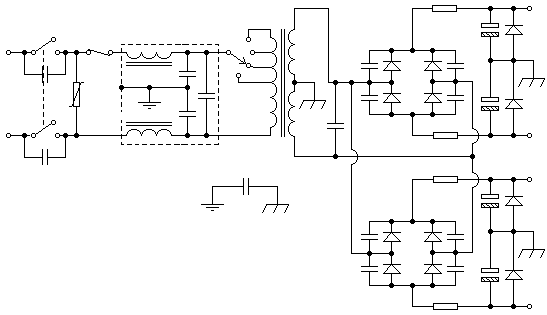
High-voltage capacitors across the mains switch suppress arcing. A varistor, immediately after, deals with large spikes and an LC filter (usually obtainable embodied in mains sockets) aids suppression of transients and other ultrasonic noise. To reduce unwanted mains noise further, a split-bobbin E-I laminated or screened toroidal transformer can be used. A capacitor links the chassis earth and the power supply 0V rail, providing a path for RF. Another across the secondary winding suppresses any components introduced by, say, radio tuners, etc. Similar types across the rectifier diodes suppress any switching transients from these and can be seen as an aid to dissipation. Low-value, high-power resistors in the DC feed will damp peaks in charging currents and aid in smoothing spurious current peaks on the supply voltage. High-power diodes clamping the rails to ground will blow fuses before other components are damaged by gross shorts.
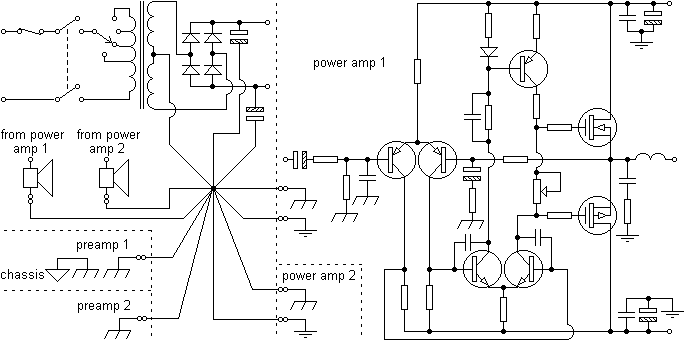
Similar arrangements should be made for other power supply connections.
Rectifier bridge |
Capacitors |
Regulators |
PSU switches
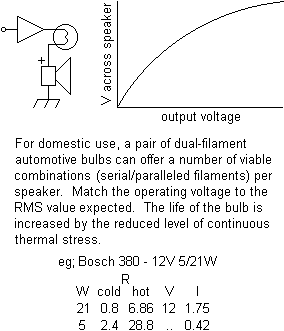
Such an approach is useful when faced with unknown or dubious loads and can be used to prevent damage to a new or repaired power supply when powering up for the first time. In this case, wiring a 60W mains light bulb in series with the mains transformer can prevent further damage occuring when power is applied. The bulb can be expected to flash briefly on switch on and output voltage measurements can be made, but if it remains lit is indicative of further unresolved issues.
load (ohms)
4
8
15
o/p voltage
20
28
39
o/p current (amps)
5
3.5
2.6
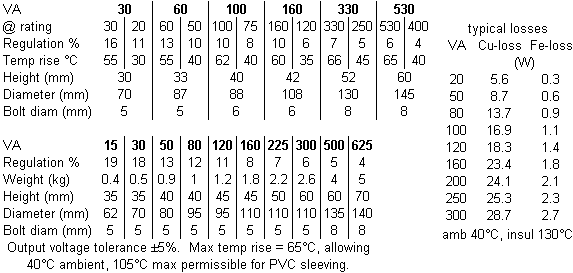
To obtain a maximum DC output from a transformer, assuming a symmetrical bridge (whose losses are ignored here), multiply the output voltage by 1.414 (root 2), then by the regulation factor, then by the tolerance and then by 10%, allowing for mains line variations, eg; for a 120VA toroid with 25-0-25 windings, the peak DC rail voltages = 25 x 1.414 x 1.11 x 1.05 x 1.1 = ±45.3V.
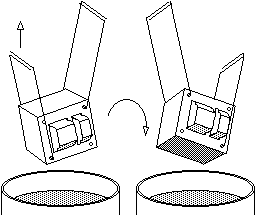
Extra windings can be added to a transformer, most easily in the case of a toroid, if say, a higher voltage for pre-driver stages is required. Ensure that these are tight, well insulated and do not interfere with any mounting arrangements. If adding windings of enamelled copper wire, do not handle the wires with fingers - acids in finger-prints can deteriorate the insulation and cause failures.
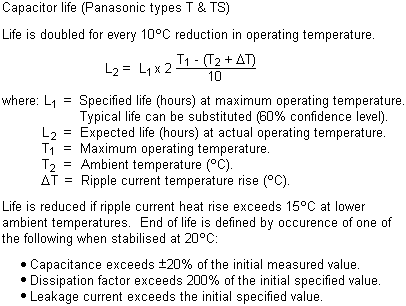
Similar principles apply to non-electrolytic types and should be considered if mounting capacitors, of any kind, near output devices, heat-sinks or other heat sources.

The safe ripple current is not only frequency but also temperature dependent. For example, the same capacitor may quote 140% at 20°C, 120% at 40°C, 80% at 70°C and only 40% at 85°C. Another might quote 75% at 50Hz, 80% at 60Hz, 100% at 120Hz, 120% at 500Hz, 125% at 1kHz and 140% at 10-50kHz. Some will give a ripple rating based on an operating life at elevated temperatures, eg; Ripple (A) @ 120Hz; 4.1A @ 105°C (2000h), 5.6A @ 85°C (4000h).
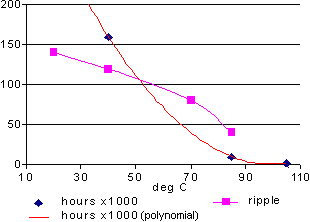
Plotting these suggests a safe operating maximum temperature of 50°C and, operating below the maximum ripple rating given, a life in excess of eleven years. Life expectancy curves for a high-grade industrial electrolytic might look like those below.
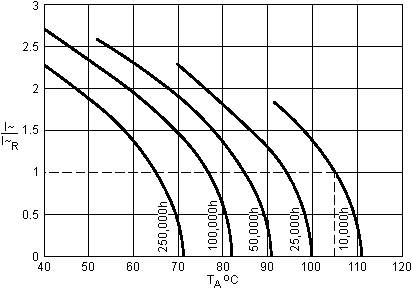
Some designs have paralleled radial smoothers to build up a large value cheaply. These can be mounted on a PCB oriented vertically so that a vertical airflow will flow around the caps whose axes (and most of their surface area) now sit horizontally. Care should be taken so that such arrangements are rugged and not easily prone to damage from physical shocks. Smaller cans, without fixing lugs, can be set with glue, for example.
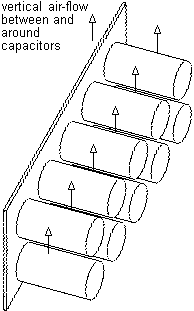
The PCB must be securely fixed to the chassis, just two right angle brackets is not sufficient.
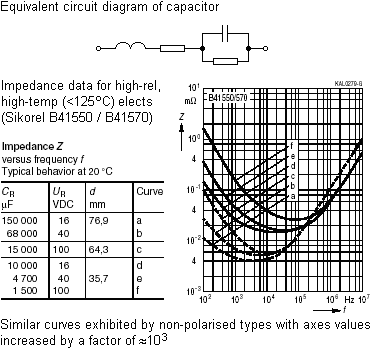
Another view of a capacitor's equivalence.
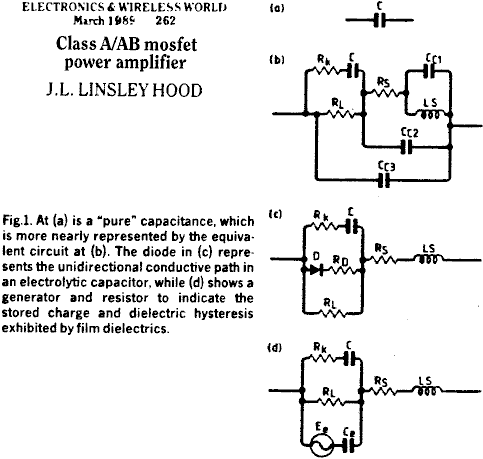
The addition of a small resistance can result in a reduction of supply noise, in this case (2/3A load) of about 20dB.

When large high power electrolytics are paralleled in big amplifiers, or when smaller values are paralleled to provide high values in compact builds, bear in mind a future need to test and replace individual capacitors with ease. A paralleled capacitor with a lower ESR than the others will be 'worked harder', just like a higher gain power transistor in a paralleled output and, as a consequence, will fail sooner.
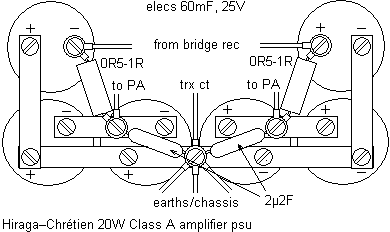
In the above arrangement with the caps passing through a chassis and secured by metal clamps, individuals can be readily isolated and removed for testing without dismantling the rest of the array.
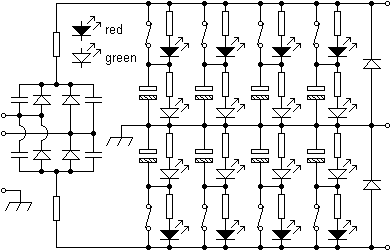
A large arrangement for 'test-bed' purposes might be fed by an equally heavy-duty transformer with multiple taps to suit any amplifier or load expected. With such arrays, a soft-start is mandatory.
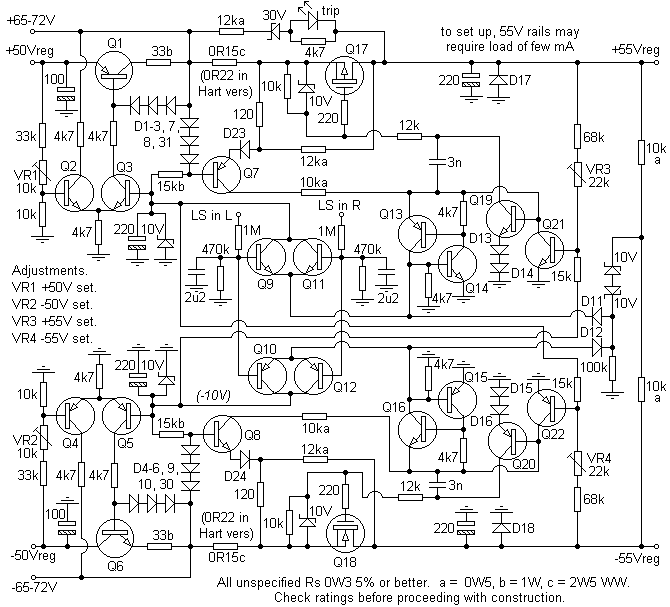
although cruder arrangements have been used, particularly in higher quality AC-coupled power amps of the '70s. The latter approach has been used in higher power designs.
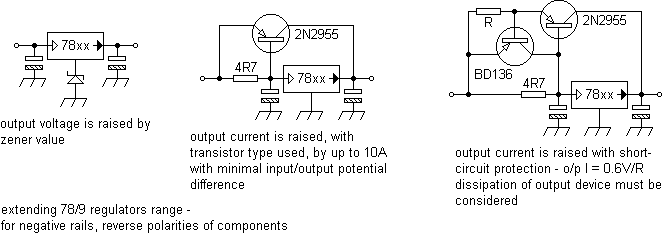
Jim Lesurf considers the non-use of a regulator in the Armstrong 732 here. The addition of a simple ramped regulator in a small amplifier can reduce hum, crosstalk and switch-on thumps, giving quite acceptable performance. A couple of examples are shown below.
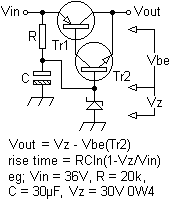

A suitable regulator for a low output class A amplifier then might be
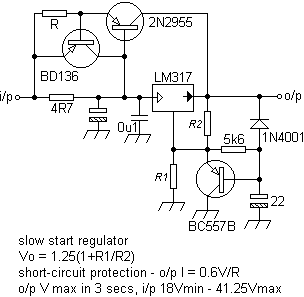
Although precision references are available, say for BCD and A to D or D to A applications, as are band-gap and temperature compensated devices, zeners are perfectly adequate for audio purposes. If precision is required, zero temperature coefficients are usually found when the negative zener breakdown matches that of the positive avalanche, about 5 to 6V. The BZY88 series might quote some -1mV/°C for 4V3 and +0.3mV/°C for 4V7, but some +12.5mV/°C for 15V. Higher voltages can be obtained by wiring combinations in series. Best stabilisation occurs when a zener draws a current of 5-10% Iz max, 5mA usually giving good results. If using regulators whose output is set by resistors, then these should have as low a thermal coefficent as is possible or reasonable, ie; metal-film or wirewound, or be over-rated.
LEDs can provide a very stable reference and are often seen as part of a current source in some amplifiers. A 5mm red or green LED will give a drop of 2V and an orange or yellow type will give 1.9V. Tests with freezer spray and hot air guns gave an accuracy of 0.1V, stable to <10mV.
Like a rectifier bridge, ideally, a regulator should be able to protect itself from anything the designer can and cannot think of throwing at it, including gross short-circuits of a permanent nature. This can conflict with load protection needs. Fuses can precede a regulator which must then be capable of dissipating the energy required to repeatedly blow these, by a significant margin. Sometimes a crowbar circuit will be included to prevent damage arising from a dangerous overvoltage, say from a short-circuited regulator series-pass output device. The zener, whose voltage is selected to be just above the output rail's normal operating voltage, will conduct turning on the thyristor which in turn blows the fuse. Other designs will place the thyristor across the supply's reference, this being reset by switching the mains off and on.
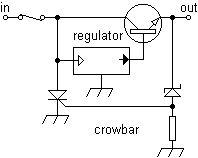
Bear in mind that any failure in a system which acts upon another, will produce a fault condition which will, in all probability, result in failure of the primary system which is working perfectly. For example, in a limited or poor design, the crowbar circuit shown above might be sensitive to mains spikes. It is sometimes thought that a regulator's existence is 'stable', however, sometimes they are worth considering as a very lively barrier between the transients that they both take and feed simultaneously.
Some systems allow for a fast shutdown negating the need for an output relay. However, problems can occur with spurious triggering caused by LF signals, especially from digital media. As regulator output devices, V-FETs appear to have a higher survivability than, say, Darlingtons.
Some power amplifier designs can use IC regulators, such as the 5A LM338K. Long lead lengths between an IC regulator and it's associated setting and by-pass components can only invite instability; mount both close together on the same PCB.
Normally fed from the main supply rails, any preamp and low-level circuit's supplies should be well smoothed and regulated, as a matter of course. Many proprietory types are available. Observe layout, dissipation and rating limitations, over-rating current by 50% minimum. A resistor in series with a regulator will assist dissipation, bearing in mind in an integrated design the drop in the supply lines with load, eg; for the 120VA toroid with 25-0-25 windings mentioned above, the on-load DC rail voltages might be = 25 x 1.414 x 0.89 x 0.95 x 0.9 = ±26.9V, compared to an estimated off-load maximum of ±45.3V, a difference of 40%. In this case, a 15V regulator supplying 100mA will be dissipating anything between 1.2W and 3W. A 47R resistor in series with the regulator will dissipate about 0.5W, and help to limit current surges. Alternatively, a 20V 1W3 zener has fed a 5V regulator for a PIC from a 35V rail.
Some 78x/79x series regulators can be very noisy compared to adjustable types like the LM317/37 types, although discrete designs can offer better performance. A post filter of a 10R resistor and a 470µF-1mF electrolytic can help alleviate this. These short-comings led Armstrong to use a relatively simple supply arrangement in their high-end 730 preamp. With audio it is not so important to maintain a precise voltage level as removing and absorbing supply rail noise whether this arises from the supply or the circuitry supplied.

Ceramic caps (0.1µF) paralleled with the electrolytics can do no harm as can similar types across the AC rails. Examples of active hum filters.
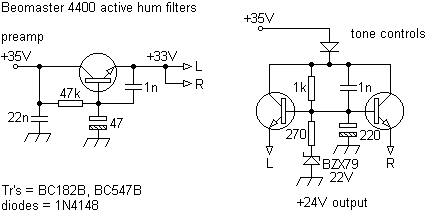
An arrangement that drove the series pass device with a FET was called a 'virtual battery' in the Technics SU-C2000 remote-controlled stereo preamp.

The JLH 'ripple eater' is covered adequately by Jon Clancy. This can offer the equivalent of 0.5F smoothing.
A design for a RIAA preamp is shown below. The regulator in this case was bolted to the screening can.
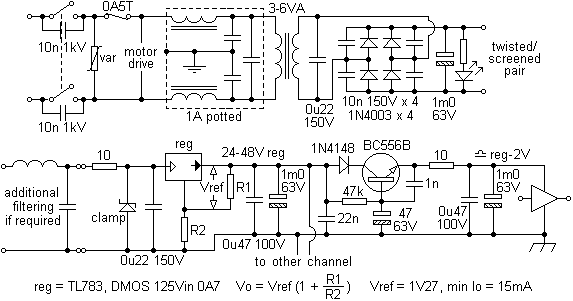
If desired, a thermistor can be placed in series before the mains filter. Notwithstanding generous suppression on the motor drive, zeners on supply rails will effectively clamp spikes if set just above the rail operating voltage. In this case, a 1W device in a pre-regulator position would suffice, thus respecting the regulator's maximum input voltage by a safe margin (spikes being considered a major source of 78L series regulator's failures). A design giving a continuous 50mA, with separate hum filters for each channel, should meet most needs. A load, such as an led, can help reduce high quiescent voltages from a high impedance secondary.
When increasing a component count 'where there is more to go wrong', increase the component's ratings to reduce failure rates. For example in the supply above, upgrading the 63V caps to 100V types and the 100-150V types to, say, 200V will extend life appreciably, and at pence for years, reducing the need for access.
Portable low-voltage, low-noise gain blocks were run very successfully from LM2931 (5V) series low dropout regulators fed by a 9V PP3 battery, giving extended supply life (see 'Battery operation').
To reduce dissipation in the output stages supply rails may be selected to suit demand. In class H operation higher voltage rails are switched in to cope with peaks. In ICs that can be found in 4 channel CD stereo systems, comparators monitor the output voltages of both PAs with respect to a reference and when a peak is detected Darlington arrangements bring in the relevant rail.
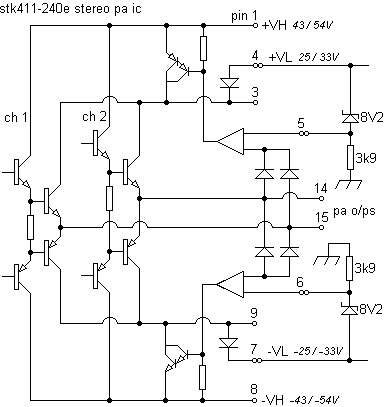
In the next case, a similar arrangement is used, however, a retriggerable monostable multivibrator extends the switching period, in this case by some 0.3s. Presumably this solution was found necessary to warrant it's inclusion.
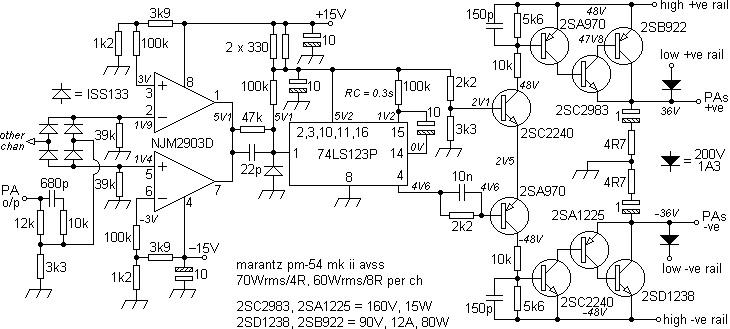
Note that only one channel need peak for both channels to have full-power applied to them. High power, low component count, 'high efficiency' solutions can be found in the TDA7293/4's DMOS ICs datasheets.
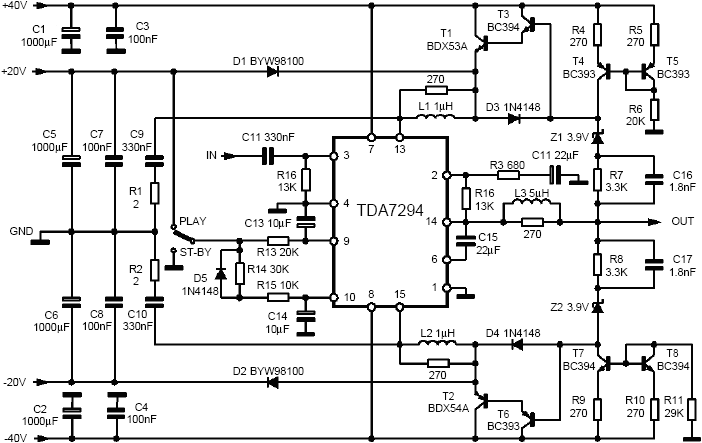
Interestingly in the above examples, switching phenomena are inaudible by even 'audiophile' users thus rendering questionable the use of separate supplies to 'overcome' cross-talk between PAs via the supply.
Apart from a SVITA7317P muting/relay drive IC used to detect power and any output DC, the Technics SE-A7 used additional circuitry to set both it's transformers secondary voltages (via an additional relay) by detecting the load's impedance, prior to power up (37-0-37Vac for 8~16R and 32-0-32Vac for 4~6R).

Contact me at paulkemble@hotmail.com
especially if you want additional content to this page
or if you find
any links that don't work. Don't forget
to add the page title or URL. Take care!